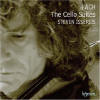Texte paru dans: / Appeared in:
*

Fanfare Magazine # 31:2 (11/12 - 2007)
Pour
s'abonner / Subscription information
Les abonnés à Fanfare Magazine ont accès aux archives du
magazine sur internet.
Subscribers to Fanfare Magazine have access to the archives of the magazine
on the net.
Hyperion
CDA 67541/2

Code-barres / Barcode:
0034571175416
Steven Isserlis is known for his dedication to contemporary music and for his inquisitive intelligence, which has led him to try his hand at such unusual activities as writing children’s books. He approaches these seminal works at the height of his maturity and technical powers. The result is a stable performance, the tone round and focused, the intonation fine, the phrasing confident and clear. Isserlis plays with audible love and commitment, and with intellectual as well as emotional empathy. The text in the booklet is very interesting, and sheds light on the interpreter’s viewpoint concerning these works, which is worth knowing. Sound engineering, by Simon Eadon, is true to life, with space around the sound while retaining the feel of intimacy that the interpreter projects. Overall, this is a delicate, dedicated production. Yet there is something missing, and it took me a while to figure out what it was. Strange as it may seem, this recording suffers from an excess of care, an exaggerated reverence for the music that ends up weighing down the interpretation, like oil on a bird’s wings.
I was a bit puzzled by the
inclusion of the three extra versions of the prelude of the first Suite. To
my innocent mind, if I were to record four versions of any piece on a single
CD, I would certainly want them to be as different as possible. I fully
expected insane (and invigorating!) approaches to this movement, with wild
tempo variations, crazy accents, surprising (even tasteless!) ornamentation.
Nothing of the sort was forthcoming. All four versions are equally well
behaved and discreet. And if for Isserlis the differences might seem huge,
to the normal listener they are minor, really, and will appeal mostly to
cellists or to the obsessive-compulsive listener, who sits on his sofa to
listen to his CDs, music score in hand. One needs but compare the timings
(only five seconds separate the fastest from the slowest version). Part of
the reason is exactly that Isserlis treats Baroque music with the unwavering
respect that is so common among modern performers. And yet musicological
research has moved on to establish that at the time there was ample freedom
as concerns tempos, inflection, articulation, ornamentation.
The fact itself that Isserlis attaches so much importance to the differences
in the manuscripts and tries so hard to be meticulous and give every detail
his total consideration can be seen as both a quality and a defect. The
different versions that survived are proof (if proof be needed) that for
Baroque musicians (even for Bach) the notes on the page were a rough guide,
not a map to be followed blindly at the risk of missing the exact spot where
the treasure trove was buried. There are many contemporary reports that
assure us that each time a piece was played in the 18th century, it was
interpreted slightly differently, depending on the acoustics of the venue,
the kind of audience present, even the mood of the interpreter. Fidelity to
the text was not really the main quality interpreters strived for, and to be
so loyal to the letter is a small betrayal to the spirit. I would really
love to see Isserlis go much beyond the fine line he has forbidden himself
to cross, throwing all caution aside, not aiming to find the ultimate
version of a Bach prelude, but rather digging really deep into his own
engaging personality.
This release still has plenty to recommend it (including the Catalan folk song, The Song of the Birds, offered as a tribute to Pablo Casals), and is surely a good option among the many fine versions available, but would not be my first choice. The two radically different recordings by Antonio Meneses still enrapture me more, as does Maisky’s sensitive readings. In the unique/unusual category, my vote goes to Paolo Pandolfo’s absolutely peculiar but riveting conception, played on the gamba. And if one is to be a stickler for authenticity, maybe the obvious choice of instrument should be the Baroque cello.
Cliquez l'un ou l'autre
bouton pour découvrir bien d'autres critiques de CD
Click either button for many other reviews


